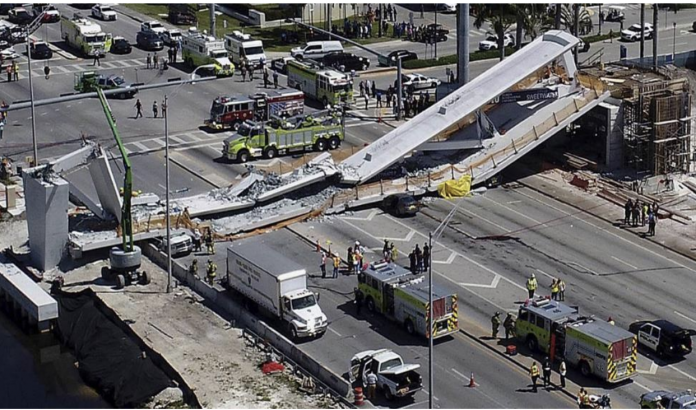The federal Occupational Safety and Health Administration (OSHA) has determined there were many errors in the design and construction of the Florida International University pedestrian bridge that collapsed in 2018, killing six people.
The OSHA investigative report, written by Mohammad Ayub, director, Office of Engineering Services, lays out specific observations about FIGG Bridge Engineers — assertions the Tallahassee-based engineering practice has denied in a statement sent to Engineering News-Record (ENR),
The complete OSHA report about the FIU bridge collapse
The report asserts that FIGG Bridge Engineers’ “deficient” design led to the bridge’s structural failure. As well, FIGG’s attempt to close the cracks, which triggered the collapse, was a fatal action.
FIGG was the project’s engineer of record (EOR) for the bridge that collapsed last March 15.
FIGG “failed to recognize that the bridge was in danger of collapsing when it inspected it hours before the collapse,” Ayub writes.
After noting the development of numerous “wide and deep structural cracks” along the structure’s single concrete truss, “The EOR (engineer of record) should have immediately instructed that the bridge be shored at appropriate locations and SW 8th Street be closed.”
As well, OSHA reports that the bridge “had structural design deficiencies that contributed to the collapse during construction stage III. The cracks on the bridge occurred due to deficient structural design.”
The lack of action after a project team meeting to discuss increasing cracking on the bridge structure, held the morning of the collapse, seemed to puzzle OSHA investigators.
“At that meeting, the EOR acknowledged that his computations could not replicate the cracks and therefore, he did not know why the cracks were occurring,” Ayub writes. “The Construction Engineer and Inspector (CEI) of the project advised the EOR at this meeting that the cracks were lengthening daily. Despite these admissions and the knowledge that the cracks were growing in size, EOR stated more than once that the cracks did not present any safety concerns.
In a statement to ENR, FIGG disputed OSHA’s findings, calling the report “factually inaccurate and incomplete” with “errors and flawed analyses.”
The OSHA FIU Pedestrian Bridge report “does not include an evaluation of many important factors pertinent to the construction process leading up to the accident. Additionally, it has not been reviewed by any other entities involved in the accident investigation. FIGG disagrees with the conclusions in the OSHA report.”
The engineer added: “As a party member to the NTSB (investigation) process, we are not able to elaborate further, but at the appropriate time the facts and the truth will be released to the public.”
OSHA also places some blame on the contractor, Munilla Construction Management, for not using “independent judgment with regard to implementing necessary safety measures” after FIGG disregarded concerns over growing cracks on the morning that the 930-ton portion of the bridge fell.
MCM filed for Chapter 11 bankruptcy protection earlier this year.
The OSHA report also said that FIU and the Florida Department of Transportation should have stepped in the morning of the collapse and had independent experts review FIGG’s conclusions.







